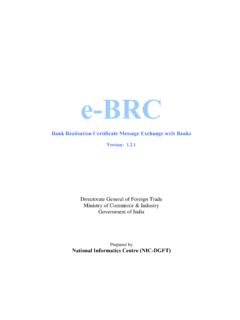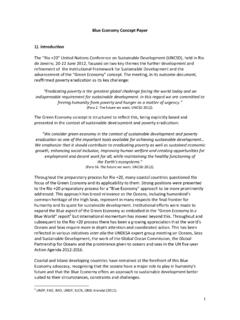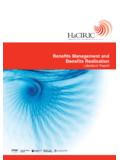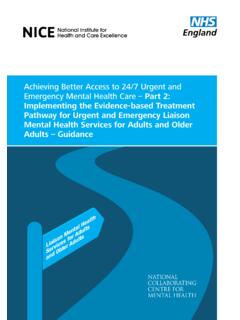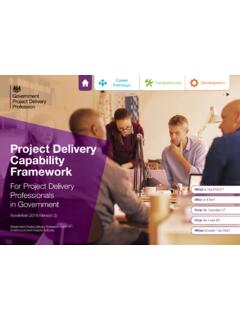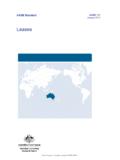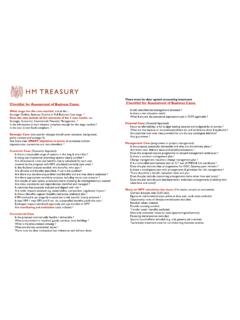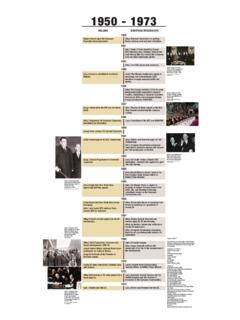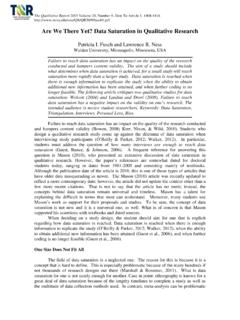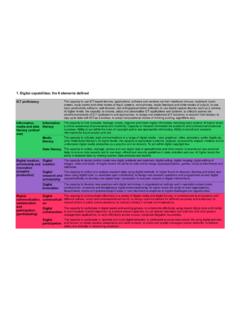Transcription of The Green Book - GOV.UK
1 THE Green BOOKCENTRAL GOVERNMENT GUIDANCE ON APPRAISAL AND EVALUATION2022 Crown copyright 2022 This publication is licensed under the terms of the Open Government Licence except where otherwise stated. To view this licence, visit or write to the Information Policy Team, The National Archives, Kew, London TW9 4DU, or email: we have identified any third party copyright information you will need to obtain permission from the copyright holders publication is available at enquiries regarding this publication should be sent to us at 978-1-5286-2229-5PU3051 THE Green BOOKCENTRAL GOVERNMENT GUIDANCE ON APPRAISAL AND EVALUATION2022 This version first published edition with minor updates published in 2022, see page vii for Green BookContents1. Introduction 1 Scope and relationship with other appraisal guidance 42. Introduction to Appraisal and Evaluation 5 Principles of appraisal 5 Rationale 7 Generating Options and longlist appraisal 7 Shortlist appraisal 8 Monitoring and Evaluation 113.
2 The Overarching Policy Framework 13 Policy and Strategic Planning an Overview 13 The Five Case Model 18 Regulatory Impact Assessments 22 Option appraisal in government 224. Generating Options and Long-list Appraisal 23 Rationale 23 SMART objectives 25 Important factors when considering the longlist 26 Longlist appraisal with Options Framework-Filter 29 Option choices and the options framework-filter 325. Shortlist Options Appraisal 39 Social Cost Benefit and Cost Effectiveness Analysis 40 Social costs and benefits 40 Adjustments for inflation 42 Discounting and Social Time Preference 45 Unintended consequences 47 Uncertainty, risk, optimism bias 47 Preferred option selection 49 Sensitivity analysis 52 Equalities analysis at the shortlist stage 54 Distributional analysis at the shortlist stage 54 Appraising projects and programmes 55 Portfolio appraisal 56 Competitive bids 566.
3 Valuation of Costs and benefits 57 Opportunity cost 57 Employment and productivity effects 57 Economic transfers 58 Residual values and other adjustments 58 Non-market valuation 58 Specific approaches to valuation 60 PPP, tax and other adjustments 64 Unmonetisable and unquantifiable costs and benefits 65iiiThe Green BookContents7. Presentation of Results 66 Appraisal Summary Tables 668. Monitoring and Evaluation 69A1. Non-market Valuation and Unmonetisable Values 73 Environmental and natural capital 73 Land values 81 Energy efficiency and Greenhouse Gas (GHG) values 82 Life and health 84 Travel Time 87 Unmonetisable values 88A2. Place Based Analysis 90 Definition 90 When to employ place based analysis 90 Inclusion of employment and productivity effects 92 Leakage, displacement, and substitution 92A3. Distributional Appraisal 96A4. Public Private Partnerships 99 Overview of PPP options 99 benefits and risks of PPP options 101 Treatment of costs in PPP options 102A5.
4 Uncertainty, Optimism Bias and Risk 104 Definitions 104 Adjusting for optimism bias 104 Monitoring and Sensitivity Analysis 105 Risk quantification 105 Risk management and categories of risk 109 The interaction between risk, optimism bias and contingency 114A6. Discounting 116 Role of discounting 116 Breakdown of the discount rate 116 Exceptions to the standard STPR 118 Long term discounting 118 Intergenerational effects 119 Discounting and inflation 119A7. Transformation, Systems and Dynamic Change 122 Definition of Transformation and roles of Systems and Dynamic considerations 122 List of Green book Supplementary Guidance 125 Glossary 126 Bibliography 132ivThe Green BookContentsList of FiguresFigure 1.
5 The Green book and Appraisal in Context 3 Figure 2. Policy and the wider context Political, Economic, Social, Technological, Environmental, Legal (PESTLE) 13 Figure 3. From Policy to Outcomes 14 Figure 4. The ROAMEF Policy development cycle 15 Figure 5. A generic example of the relationship between Strategy, Programmes and Projects 16 Figure 6. A hypothetical applied example the relationships between Strategy, Programmes and Projects 25 Figure 7. Overview of Longlisting with the Options Framework-Filter process 34 Figure 8. The Options Framework-Filter summary matrix 37 Figure 9. The Natural Capital Framework 63 Figure 10. Generic Core Appraisal Summary table template 68 Figure 11. The Impact Pathway Approach 85 Figure 12. Illustration of longevity effects 86 Figure 13. Methodology for Income Equivalisation 97 List of TablesTable 1. Adjusting for the Effects of Inflation (Using a 2% GDP Deflator) 42 Table 2. Present Values and Discount Rate 46 Table 3: Summary of environmental values, and land value uplift, referenced in Annex 1 (20/21 prices) 83 Table 4.
6 Quintile Groups of all Households Ranked by Equivalised Disposable Income (Based on Weekly Income Before Housing Costs 2019/20) 98 Table 5. Declining Long Term Discount Rate 119 Table 6. Standard Discount Rates and Associated Discount Factors 120 Table 7. Health Discount Rates and Associated Discount Factors 121vThe Green BookContentsList of BoxesBox 1. Scope of Green book Guidance 2 Box 2. Summary Outline of Key Appraisal Steps 6 Box 3. The meanings of widely used words as they are used in the Green book 6 Box 4. Guidance and definitions and for managing successful Programmes and Projects 17 Box 5. The Five Case Model 19 Box 6. Logical Change Process 20 Box 7. Navigating the Appraisal Framework: the Rationale 24 Box 8. Navigating the Appraisal Framework and the Longlist 31 Box 9. Critical Success Factors 32 Box 10. Choices in the Strategic Options Framework-Filter 33 Box 11. Navigating the Appraisal Framework and the Shortlist 39 Box 12. Classification of Costs and benefits 41 Box 13.
7 Definitions of Costs 43 Box 14. benefits Register Template 45 Box 15. NPSV and Discounting Worked Example 47 Box 16. Optimism Bias Case Study 49 Box 17. Navigating the Appraisal Framework the Option Selection and VfM 50 Box 18. A Definition of Value for Money 52 Box 19. Switching Values Worked Example 53 Box 20. Valuation Methods for Non-Market Prices 59 Box 21. Uses of Evaluation 69 Box 22. Core Evaluation Questions 72 Box 23. Identifying whether an intervention may affect Natural Capital 74 Box 24. Place Based analysis for projects without a specific spatial focus 91 Box 25. Place Based analysis for projects with a specific spatial focus 91 Box 26. Place Based ( Sub-UK) Employment multipliers 93 Box 27. Hypothetical Illustration: Calculating place based employment effects 94 Box 28. Qualitative Issues when Considering PPP Options 100 Box 29. Example of Single Point Probability 106 Box 30. Example of Multi-Point Probability 106 Box 31. Example of Real Options Analysis 108viThe Green BookContentsBox 32.
8 Business Risks 111 Box 33. Service Risks 112 Box 34. External Risks 112 Box 35. Risk Register 114 Box 36. Example of Risk Allocation Table 114 Box 37. Calculation Of STPR 118viiThe Green BookContentsSummary of Green book 2022 ChangesThe Green book received a maintenance refresh in March 2022. Changes from Green book 2020 are summarised of changeLocation (page, paragraph/table numbers)Updated hyperlinks, references, and email addressesUpdated for changes since Green book 2020 VariousDevelopment of departmental and supplementary Green book guidanceRole of HM Treasury in development of guidance clarifiedP4, riskGuidance added regarding fraud risk to the public sectorP10, and P109, terms growth in valuesTransparency requirement introduced in business cases where values grow in real termsP42, and BCR constructionAmended guidance on the creation of NPSV and BCRs in appraisalP50-51, - supplementary guidanceGuidance added on use of wellbeing in appraisalP60, Valuation and Greenhouse Gas emissionsAnnex 1, environmental valuation guidance refreshed throughout, Table 3 added to summarise key environmental values referenced in the Green book .
9 Updated guidance to reflect BEIS carbon values September 2021 , - , Table 3 Willingness to Pay for a Quality Adjusted Life YearClarified value as 70,000 in 20/21 pricesP87, appraisalEquivalised disposable income by quintile updatedP98, Table 41 The Green The Green book is guidance issued by HM Treasury on how to appraise policies, programmes and projects. It also provides guidance on the design and use of monitoring and evaluation before, during and after implementation. Appraisal of alternative policy options is an inseparable part of detailed policy development and design. This guidance concerns the provision of objective advice by public servants to decision makers, which in central government means advice to ministers. In arms-length public organisations the decision makers may be appointed board members, and where local authorities are using the method,1 elected council members. The guidance is for all public servants concerned with proposals for the use of public resources, not just for analysts.
10 The key specialisms involved in public policy creation and delivery, from policy at a strategic level to analysis, commercial strategy, procurement, finance, and implementation must work together from the outset to deliver best public value. The Treasury s five case model is the means of developing proposals in a holistic way that optimises the social / public value produced by the use of public resources. Similarly, there is a requirement for all organisations across government to work together, to ensure delivery of joined up public The Green book is not a mechanical or deterministic decision-making device. It provides approved thinking models and methods to support the provision of advice to clarify the social or public welfare costs, benefits , and trade-offs of alternative implementation options for the delivery of policy Use of the Green book should be informed by an understanding of other HM Treasury guidance.










